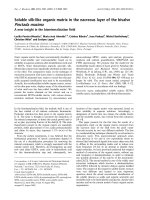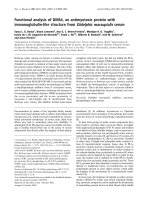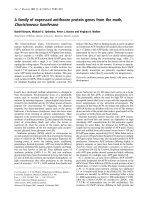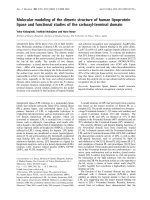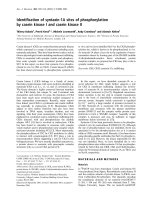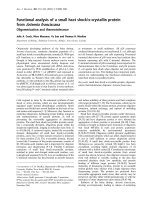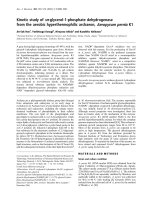Báo cáo Y học: Oxidative deamination of lysine residue in plasma protein of diabetic rats Novel mechanism via the Maillard reaction pdf
Bạn đang xem bản rút gọn của tài liệu. Xem và tải ngay bản đầy đủ của tài liệu tại đây (410.67 KB, 8 trang )
Oxidative deamination of lysine residue in plasma protein
of diabetic rats
Novel mechanism via the Maillard reaction
Mitsugu Akagawa, Takeshi Sasaki and Kyozo Suyama
Department of Applied Bioorganic Chemistry, Division of Life Science, Graduate School of Agricultural Science,
Tohoku University, Japan
The levels of a-aminoadipic-d-semialdehyde residue, the
oxidative deamination product of lysine residue, in plasma
protein from streptozotocin-induced diabetic rats were
evaluated. a-Aminoadipic-d-semialdehyde was converted to
a bisphenol derivative by acid hydrolysis in the presence of
phenol, and determined by high performance liquid chro-
matography. Analysis of plasma proteins revealed three
timeshigherlevelsofa-aminoadipic-d-semialdehyde in dia-
betic subjects compared with normal controls. Furthermore,
we explored the oxidative deamination via the Maillard
reaction and demonstrated that the lysine residue of bovine
serum albumin is oxidatively deaminated during the incu-
bation with various carbohydrates in the presence of Cu
2+
at a physiological pH and temperature. This experiment
showed that 3-deoxyglucosone and methylglyoxal are the
most efficient oxidants of the lysine residue. When the
reaction was initiated from glucose, a significant amount of
a-aminoadipic-d-semialdehyde was also formed in the
presence of Cu
2+
. The reaction was significantly inhibited by
deoxygenation, catalase, and a hydroxyl radical scavenger.
The mechanism we propose for the oxidative deamination is
the Strecker-type reaction and the reactive oxygen species-
mediated oxidation. Based on these findings, we propose a
novel mechanism for the oxidative modification of proteins
in diabetes, namely the oxidative deamination of the lysine
residue via the Maillard reaction.
Keywords: Maillard reaction; glycation; reactive oxygen
species; a-aminoadipic-d-semialdehyde; oxidative deamina-
tion.
The Maillard reaction (nonenzymatic glycation) is thought
to contribute to the pathogenesis of diabetic complications
and the ageing process. The first step in this reaction is the
formation of a Schiff base between a reducing sugar and an
amino group in proteins, followed by an Amadori rear-
rangement to yield a relatively stable ketoamine adduct.
Subsequently, the adducts (Amadori products) are further
degraded to form a variety of structurally diverse com-
pounds known as advanced glycation end products (AGEs)
which frequently have chromophores, fluorophores, and
protein cross-links [1]. Recent researches have demonstrated
that the formation and accumulation of AGEs in plasma
and tissue are associated with aging [1–5] and the long-term
complications of diabetes [1,6–10].
In the process of the Maillard reaction, several reactive
a-dicarbonyl compounds are found in vitro and in vivo.
3-Deoxyglucosone (3-DG) is produced from the multiple
dehydration in the early stage Maillard reaction and by the
fragmentation of fructose 3 phosphate [11,12]. Methylgly-
oxal (MG) is mainly formed by amine-catalyzed sugar
fragmentation reactions and by spontaneous decomposition
of triose phosphate intermediates in glycolysis [12]. Glyoxal
(GO) is formed by the spontaneous oxidative degradation
of glucose, the degradation of glycated proteins, and lipid
peroxidation [12]. In addition, increased levels of 3-DG,
MG, and GO are found in blood from diabetic patients and
streptozotocin (STZ)-induced diabetic rats [11–14]. In the
advanced stages of the Maillard reaction, these a-dicarbonyl
compounds irreversibly modify lysine and arginine residues
in proteins at physiological conditions, leading to the
formation of various AGEs in vitro, which are also identified
in vivo [1,5,7–10,15,16]. Therefore, a-dicarbonyl compounds
have been recognized as the major intermediates and
precursors in AGEs formation in vivo. Recently it has been
proposed that a-dicarbonyl stress is among the major
factors in the pathogenesis of diabetic complications
[1,7,11,16].
The oxidative degradation of a-amino acid by a-dicar-
bonyls is known as the so-called Strecker degradation in
food science. In the Strecker degradation [17,18], a number
of carbohydrate-derived a-dicarbonyls as well as glucose are
able to degrade a-amino acids at high temperatures, thus
generating an aldehyde with one carbon atom less than
a-amino acids. On the other hand, o-quinone compounds,
which have an a-dicarbonyl group, are known to catalyze
the oxidative deamination of primary amines to form the
corresponding aldehydes under physiological conditions
Correspondence to K. Suyama, Department of Applied Bioorganic
Chemistry, Division of Life Science, Graduate School of Agricultural
Science, Tohoku University, Tsutsumidori-Amamiyamachi,
Aobaku, Sendai 981–8555, Japan.
Fax: +81 22 717 8820, Tel.: +81 22 717 8818,
E-mail:
Abbreviations: ACPP, 1-amino-1-carboxy-5,5-bis-p-hydroxyphenyl-
pentane; AGE, advanced glycation end-product; 3-DG, 3-deoxy-
glucosone; LTQ, lysine tyrosylquinone; MG, methylglyoxal;
GO,glyoxal;STZ,streptozotocin.
Enzyme: lysyl oxidase (EC 1.4.3.13).
(Received 14 May 2002, revised 4 September 2002,
accepted 9 September 2002)
Eur. J. Biochem. 269, 5451–5458 (2002) Ó FEBS 2002 doi:10.1046/j.1432-1033.2002.03243.x
[19]. Lysyl oxidase (EC 1.4.3.13), a copper-containing
amine oxidase, catalyzes the oxidative deamination of the
e-amino group of lysine residue of elastin and collagen,
which are connective tissue proteins, to form a-aminoadi-
pic-d-semialdehyde [20]. Lysyl oxidase has a lysine tyrosyl-
quinone (LTQ) cofactor consisting of an amino-o-quinone
skeleton at the active site [21,22], and the LTQ cofactor itself
catalyzes the amine oxidation [23]. The a-dicarbonyls
derived from the Maillard reaction exist as free compounds
in vivo and thus potentially may serve as adventitious
oxidants of amines possibly including protein lysine residues
and, in the course of the oxidative deamination, generate
a-aminoadipic-d-semialdehyde.
On the other hand, it was recently found that
a-aminoadipic-d-semialdehyde is produced from protein
lysine residue by the attack of oxygen-derived free radicals
[24–26]. In addition, the aldehyde residue has been identified
in serum albumin collected from some mammalian species
[24]. The Maillard reaction can give rise to oxygen free
radicals in the presence of O
2
and transition metal ions [27–
30] and the formation of some AGEs has been shown to
require oxygen free radicals [30–32]. Therefore, the oxygen
free radicals derived from the Maillard reaction in vivo may
also serve as adventitious oxidants of lysine residues.
a-Aminoadipic-d-semialdehyde residue is known as a pre-
cursor of cross-links in elastin and collagen [21–23], thus
implying the formation of cross-links, i.e. AGEs.
In the present study, we measured the a-aminoadipic-d-
semialdehyde in plasma protein. Analysis of rat plasma
proteins by RP-HPLC revealed significantly higher levels of
a-aminoadipic-d-semialdehyde residues in STZ-induced
diabetic rats compared with normal controls. Furthermore,
we explored the oxidative-deamination reaction via the
Maillard reaction and demonstrated the occurrence of
the oxidative deamination of the lysine residues in BSA via
the Maillard reaction at a physiological pH and tempera-
ture. Based on these findings, we propose a novel mechan-
ism for the oxidative modification of proteins in diabetes,
namely the oxidative deamination of the lysine residue via
Maillard reaction.
MATERIALS AND METHODS
Materials
Methanol was of HPLC grade from Nacalai Tesque Co.,
Kyoto, Japan.
D
-Ribose and catalase from bovine liver were
from Tokyo Kasei Co, Tokyo, Japan. STZ was from Sigma
Chemical Co, St. Louis, MO. Biuret reagent was from
Wako Pure Chemical Industries Co, Osaka, Japan. 3-DG
was from Dojindo Laboratories Co, Kumamoto, Japan. All
other chemicals were from Nacalai Tesque Co.
Diabetic model rats
Animal experiments were carried out according to a
protocol approved by the Animal Care Committee of
Tohoku University. Male Wistar rats (8 weeks old, Japan
SLC Co., Shizuoka, Japan), weighing 180–200 g, were used
for the disease model study. Experimental diabetes was
induced by a single i.p. dose of STZ (55 mgÆkg
)1
). STZ was
dissolved in 0.1
M
citrate buffer (pH 4.5). The animals were
fasted overnight prior to STZ administration. Two weeks
after STZ administration, all animals with plasma glucose
level > 400 mgÆdL
)1
were considered diabetic and were
included in the study. Plasma glucose levels were measured
using the commercial kit, Glucose CII Test Wako (Wako
Pure Chemical Industries Co). Control animals received
0.1
M
citrate buffer (pH 4.5). During the experiment the rats
were housed in groups of two or three per cage. Tap water
and pelleted standard diet Laboratory MR (Nihon Nosan
Kogyo Co, Yokohama, Japan) were available ad libitum.
The rats were housed in temperature- (23 ± 1 °C), humi-
dity- (55 ± 5%), and light- (8.00–20.00 h) controlled room.
Plasma protein
After 14 days of administration, blood was drawn from the
abdominal aorta of rats under light anesthesia with diethyl
ether and placed into heparinized tubes. Plasma was
immediately prepared by centrifugation at 1500 g for
20 min. The concentration of protein in the plasma samples
was measured by the Biuret reaction using BSA as reference
protein. Each plasma sample (500 lL) in a Pyrex test tube
with a Teflon-lined screw cap was treated with 2 mL of cold
10% (w/v) trichloroacetic acid. All subsequent steps were
performed in these tubes, and all samples were kept on ice
during processing. After 5 min, the mixture was centrifuged
at 2000 g for 30 min, and the resulting pellet of precipitated
protein was separated. The pellet was washed with 2 mL of
cold 5% (w/v) trichloroacetic acid. Then the resulting
protein was hydrolyzed for RP-HPLC analysis as described
below.
Detection of a-aminoadipic-d-semialdehyde by RP-HPLC
a-Aminoadipic-d-semialdehyde was derivatized to a
bisphenol derivative, 1-amino-1-carboxy-5,5-bis-p-hydroxy-
phenylpentane (ACPP), and determined by a modification
of the previous method [33,34] as follows. The protein in a
Pyrex test tube with a Teflon-lined screw cap was
hydrolyzed in a conventional manner for 48 h at 110 °C
with 4 mL of 6
M
HCl containing 3% (v/v) phenol. The
hydrolysate was extracted twice with 2.0 mL of diethyl
ether, and the water layer was dried by rotary evaporation
in vacuo followed by reconstitution in 500 lL of distilled
water. A Sep–Pak plus C
18
environmental cartridge
(Waters Co, Milford, MA, USA) was used for prepurifi-
cation as follows. The Sep–Pak cartridge was flushed with
methanol (10 mL) and then distilled water (10 mL), and
the sample (500 lL) was put onto the cartridge. After the
cartridge was washed with 20.0 mL of distilled water,
ACPP was eluted with 4.0 mL of distilled water/methanol
(1 : 1, v/v). The eluate was evaporated to dryness in vacuo,
and then reconstituted in 500 lL of distilled water. After
filtration with a poly(vinylidene difluoride) (PVDF) syringe
filter (0.45 lm pore size, Whatman Co, Clifton, NJ), 40-lL
portion of it was injected into an HPLC apparatus with a
C-18 reversed phase column (COSMOSIL 5C
18
-AR-II,
250 · 4.6 mm, Nacalai Tesque Co). The RP-HPLC ana-
lysis was performed on a Perkin Elmer Liquid Chroma-
tograph Integral 4000 system (Norwalk, CT, USA).
Solvent A was 10% methanol, and solvent B was
methanol. The solvents were degassed by sonication and
then continuously bubbled with a slow stream of helium
during chromatography. The column was equilibrated with
5452 M. Akagawa et al.(Eur. J. Biochem. 269) Ó FEBS 2002
solvent A. The elution started with a linear gradient from 0
to 15% B in 20 min. Then solvent B was increased to 95%
over the following 15 min. Finally, the eluting solvent was
changed linearly to 100% A over a period of 20 min. The
column was reequilibrated for 15 min with solvent A
before the next run was started. The column oven was
maintained at 40 °C. ACPP was eluted at 15.4 min using a
flow rate of 1.0 mLÆmin
)1
. Quantification of ACPP was
performed by calculating the peak area of the HPLC
absorbance profile (at 278 nm) of purified ACPP and
comparing it with those of samples.
Selective reduction of a-aminoadipic-d-semialdehyde
in plasma protein
Human plasma from a nondiabetic patient was dialyzed for
24 h at 4 °C against phosphate buffered saline. For
reduction with sodium borohydride (NaBH
4
), plasma
sample (500 lL) in a Pyrex test tube with a Teflon-lined
screw cap was diluted with 3.0 mL of 0.1
M
sodium borate
buffer (pH 9.0) followed by the addition of NaBH
4
(25 mg,
0.66 mmol). For reduction with sodium cyanoborohydride
(NaBH
3
CN), plasma sample (500 lL) in a Pyrex test tube
with a Teflon-lined screw cap was diluted with 3.0 mL of
0.1
M
sodium phosphate buffer (pH 6.0) followed by the
addition of NaBH
3
CN (50 mg, 0.80 mmol). The mixture
was incubated for 24 h at 37 °C with shaking in the dark.
After incubation, each plasma sample was treated with
5 mL of acetonitrile. The mixture was centrifuged at 2000 g
for 30 min, and the resulting pellet of precipitated protein
was separated. The pellet was washed with 5 mL of
acetonitrile and 2 mL of cold 5% (w/v) trichloroacetic acid.
Then the resulting protein was hydrolyzed for RP-HPLC
analysis as described above.
Incubation of BSA with carbohydrates
General procedure. Reaction mixtures (2.0 mL) in a Pyrex
test tube with a Teflon-lined screw cap contained
10.0 mgÆmL
)1
BSA, 5 l
M
CuSO
4
, each carbohydrate, and
50 m
M
sodium phosphate buffer (pH 7.4). In some experi-
ments, we added dimethylsulfoxide (50 m
M
) or catalase
(200 UÆmL
)1
) to the mixture. Carbohydrate concentrations
are given in the respective legends to figures and tables. The
reaction mixtures containing 10 lL of toluene were incu-
bated at 37 °C with shaking in the dark. After incubation,
the mixture was treated with 2 mL of cold 10% (w/v)
trichloroacetic acid in ice bath. After 5 min, the mixture was
centrifuged at 2000 g for 30 min, and the resulting pellet of
precipitated protein was separated. The pellet was washed
with 2 mL of cold 5% (w/v) trichloroacetic acid. Then the
resulting protein was hydrolyzed for RP-HPLC analysis as
described above.
Incubation under nitrogen. The test tube was tightly fitted
with a silicone rubber cap. The tube was evacuated and then
filled with N
2
gas through a hypodermic needle. After
another hypodermic needle was inserted in the tube to serve
as an outlet port, gas was passed through the incubation
mixture for 10 min and charged until the pressure of
0.05 MPa inside the tube was reached. Then the reaction
mixture was incubated at 37 °C for 3 weeks with shaking in
the dark.
Statistical analysis
The significance of changes in the experimental variables
measured was assessed by Student’s t-test. We considered a
change with a P-value < 0.05 statistically significant. The
STATVIEW
program (StatView J-4.5, Abacus Concepts,
Berkeley, CA) was used for the analysis.
RESULTS
Detection of a-aminoadipic-d-semialdehyde
in rat plasma protein
Rat plasma protein from STZ-induced diabetic and control
subjects was investigated for the presence of a-aminoadipic-
d-semialdehyde. Protein hydrolysis with 6
M
HCl contain-
ing 3% phenol converts a-aminoadipic-d-semialdehyde to a
bisphenol derivative (ACPP) which is a condensation
product of one a-aminoadipic-d-semialdehyde residue and
two phenol molecules by Baeyer’s reaction [33,34]. After
hydrolysis, ACPP was measured by RP-HPLC using a
linear gradient solvent system. Figure 1 shows the HPLC
chromatograms of the ACPP standard and the hydrolysate
of diabetic rat plasma protein followed by detection at
278 nm with a diode array detector. ACPP was eluted in a
t
R
of 15.4 min (Fig. 1A) and observed in the hydrolyzate of
diabetic rat plasma protein (Fig. 1B). We identified the peak
as ACPP either by cochromatography with an authentic
standard or by comparing UV spectra with the standard
using a diode array detector (data not shown). The
concentration of a-aminoadipic-d-semialdehyde in rat
plasma protein from STZ-induced diabetic and control
subjects was determined using the RP-HPLC analytical
Fig. 1. Determination of a-aminoadipic-d-semialdehyde in diabetic rat
plasma protein by RP-HPLC. After the protein was hydrolyzed with
6
M
HCl containing 3% phenol at 110 °C for 48 h, ACPP, a bisphenol
derivative of a-aminoadipic-d-semialdehyde, was measured by RP-
HPLC with detection at 278 nm. (A) Chromatogram of ACPP
standard. (B) Chromatogram of hydrolyzate of plasma protein from
diabetic rat. Details are shown in the Experimental procedures section.
Ó FEBS 2002 Oxidative deamination via the Maillard reaction (Eur. J. Biochem. 269) 5453
procedure (Fig. 2). The mean ± SD of a-aminoadipic-
d-semialdehyde concentration was 3.21 ± 0.88 nmolÆmg
)1
proteinindiabetic(n ¼ 7) and 0.99 ± 0.29 nmolÆmg
)1
protein in control subjects (n ¼ 10). The 3.2-fold increase in
a-aminoadipic-d-semialdehyde was statistically significant
by Student’s t-test (P <0.001).
Selective reduction of plasma protein
We examined whether the a-aminoadipic-d-semialdehyde
residue exists as aldehyde, or Schiff base, or a mixture of the
two structures in vivo by selective reduction. Human plasma
was reduced, and then a-aminoadipic-d-semialdehyde was
analyzed by RP-HPLC. Figure 3 shows HPLC chromato-
grams of the plasma protein (A) and the NaBH
4
-reduced
plasma protein (B). The ACPP peak is abolished by the
reduction with NaBH
4
. On the other hand, reduction of
plasma protein with NaBH
3
CN, which is a selective
reductant toward Schiff base at pH 6–7 [35], only resulted
in a 5% decrease in the a-aminoadipic-d-semialdehyde peak
(Fig. 3C). This result indicates that the a-aminoadipic-d-
semialdehyde residue exists primarily as the free aldehyde
in vivo.
Oxidative deamination of lysine residue
in BSA by carbohydrates
The oxidative deamination of the e-amino groups of lysine
residue via the Maillard reaction was assessed by the
reaction of BSA with glucose. BSA (10.0 mgÆmL
)1
)was
incubated with 100 m
M
glucose in 50 m
M
sodium phos-
phate buffer (pH 7.4) in the presence and absence of 5 l
M
Cu
2+
at 37 °C. After glucose-incubated BSA was hydro-
lyzed with 6
M
HCl containing 3% phenol, ACPP was
measured by RP-HPLC. Figure 4A shows the formation of
a-aminoadipic-d-semialdehyde with the incubation of BSA
with glucose. Native BSA also contained 0.06 nmolÆmg
)1
protein of a-aminoadipic-d-semialdehyde but the content
remained constant during the incubation without carbohy-
drates. The incubation with glucose in the absence of Cu
2+
did not increase a-aminoadipic-d-semialdehyde content
(Fig. 4A). As shown in Fig. 4A, in the presence of 5 l
M
Cu
2+
, a significant amount of a-aminoadipic-d-semialde-
hyde was produced by the reaction with glucose. There was
a time-dependent increase in the concentration of
a-aminoadipic-d-semialdehyde throughout the incubation
period (3 weeks).
We also evaluated various carbohydrates as possible
oxidants of the lysine residue. The formation of a-amino-
adipic-d-semialdehyde in BSA after incubation with various
sugars for 3 weeks in the presence of Cu
2+
is summarized in
Table 1. In the case of aldose, pentoses were more effective
oxidants than hexoses. A marked increase was observed
with an ascorbic acid/Cu
2+
system that generates reactive
oxygen species. This result is consistent with a recent report
by Stadtman et al. [26]. Furthermore, a significant increase
was found with a low concentration (1.0 m
M
)ofMGand
Fig. 3. Selective reduction of a-aminoadipic-d-semialdehyde residue in
plasma protein. Plasma protein was reduced with NaBH
4
or
NaBH
3
CN as described in the Experimental procedures section. After
the protein was hydrolyzed with 6
M
HCl containing 3% phenol at
110 °C for 48 h, ACPP was measured by RP-HPLC with detection at
278 nm. (A) Intact plasma protein. (B) NaBH
4
-reduced plasma pro-
tein. (C) NaBH
3
CN-reduced plasma protein.
Fig. 2. a-Aminoadipic-d-semialdehyde levels in rat plasma protein de-
rived from STZ-induced diabetic and control subjects. After plasma
protein was hydrolyzed with 6
M
HCl containing 3% phenol at 110 °C
for 48 h, ACPP, a bisphenol derivative of a-aminoadipic-d-semialde-
hyde, was measured by RP-HPLC as described in the Experimental
Procedures section. Mean ± SD was 3.21 ± 0.88 and 0.99 ±
0.29 nmolÆmg
)1
protein in STZ-induced diabetic and controls,
respectively; P < 0.0001 by Student’s t-test.
5454 M. Akagawa et al.(Eur. J. Biochem. 269) Ó FEBS 2002
3-DG but not GO. Figure 4B,C shows the formation of
a-aminoadipic-d-semialdehyde in BSA by MG and 3-DG,
respectively, with the advance of time. BSA (10 mgÆmL
)1
)
was incubated in 50 m
M
phosphate buffer with 1.0 m
M
of
each a-dicarbonyl under a physiological pH and tempera-
ture (pH 7.4, 37 °C). As shown in Fig. 4B, in the presence
of Cu
2+
, a significant amount of aldehyde was produced by
the reaction with 3-DG but not in the absence of Cu
2+
.MG
oxidatively deaminated the lysine residue in the presence
and absence of Cu
2+
(Fig. 4C). The oxidation was appar-
ently stimulated by the addition of Cu
2+
.
Effect of scavengers on the oxidative deamination
of BSA
The presence of oxygen plays an important role in the
Maillard reaction [36], and, actually, oxygen is required for
the formation of some AGEs [30,37]. To assess for the
participation of oxygen in the reaction, BSA was incubated
with glucose, 3-DG, and MG in the presence of Cu
2+
under
nitrogen atmosphere. Indeed, the reaction under a nitrogen
atmosphere almost completely inhibited the oxidative
deamination by glucose, clearly illustrating the involvement
of oxygen in the oxidative deamination (Table 2). In
addition, the deoxygenation caused a significant decrease
in the production of a-aminoadipic-d-semialdehyde by
3-DG and MG.
Further, we investigated the participation of reactive
oxygen species in the reaction. BSA and Cu
2+
were
incubatedwithglucose,3-DG,andMGinthepresenceof
catalase and dimethylsulfoxide, which is a hydroxyl radical
scavenger. As shown in Table 2, addition of catalase
(100 UÆmL
)1
) markedly inhibited the formation of
a-aminoadipic-d-semialdehyde by glucose and significantly
inhibited it by 3-DG and MG. The oxidation of BSA by
glucose, 3-DG, and MG was also significantly inhibited in
the presence of 50 m
M
dimethylsulfoxide. These results
suggest that the hydroxyl radical is produced by the
Maillard reaction and is responsible for the a-aminoadi-
pic-d-semialdehyde formation.
DISCUSSION
In the present study, we identified the a-aminoadipic-
d-semialdehyde residue in rat plasma protein and demon-
strated that the a-aminoadipic-d-semialdehyde level in
STZ-induced diabetic rat plasma is significantly higher than
Fig. 4. Time course of oxidative deamination of BSA by glucose, 3-DG,
and MG. BSA (10 mgÆmL
)1
) was incubated with 100 m
M
glucose (A),
1.0 m
M
3-DG (B), or 1.0 m
M
MG(C)in50m
M
phosphate buffer
(pH 7.4) in the presence or absence of 5 l
M
Cu
2+
at 37 °C. After the
reaction was terminated, a-aminoadipic-d-semialdehyde was measured
by RP-HPLC.
Table 1. Formation of a-aminoadipic-d-semialdehyde by incubation of
BSA with various carbohydrates. BSA (10 mgÆmL
)1
)wasincubated
with 5 l
M
Cu
2+
and each indicated carbohydrate in 50 m
M
sodium
phosphate buffer (pH 7.4) at 37 °Cfor3weeks.a-Aminoadipic-d-
semialdehyde was quantitated by RP-HPLC as described in Experi-
mental procedures.
Carbohydrate
Concentration
(m
M
)
a-Aminoadipic-d-semialdehyde
(nmolÆmg protein
)1
)
None — 0.06
D
-Glucose 50 0.13
D
-Galactose 50 0.21
D
-Fructose 50 0.15
D
-Ribose 50 1.60
D
-Xylose 50 0.72
L
-Ascorbic acid 50 2.04
3-Deoxyglucosone 1 0.26
Methylglyoxal 1 0.32
Glyoxal 1 0.07
Ó FEBS 2002 Oxidative deamination via the Maillard reaction (Eur. J. Biochem. 269) 5455
that in normal rat plasma. Analysis of selectively reduced
plasma protein suggested that the a-aminoadipic-d-semial-
dehyde residue exists primarily as the free aldehyde form
in vivo. Furthermore, we explored the oxidative-deamination
reaction via the Maillard reaction, and demonstrated the
occurrence of the oxidation of the lysine residue of BSA in
the incubation with various carbohydrates in the presence of
Cu
2+
at a physiological pH and temperature. This experi-
ment showed that 3-DG and MG are the most efficient
oxidant of the lysine residue. When the reaction was
initiated from glucose, a significant amount of a-aminoad-
ipic-d-semialdehyde was also formed in the presence of
Cu
2+
. We have also determined the effects of oxygen and
scavenger on the oxidative deamination. The formation of
a-aminoadipic-d-semialdehyde by glucose, 3-DG, and MG
was inhibited by deoxygenation, catalase, and dimethylsulf-
oxide. From these results we propose the Strecker-type
reaction by a-dicarbonyls and the reactive oxygen species-
mediated oxidation for the oxidative deamination mechan-
ism via the Maillard reaction. The proposed mechanism of
the formation of a-aminoadipic-d-semialdehyde from the
lysine residue by the Strecker-type reaction is summarized in
Fig. 5. The formation of a-dicarbonyls is induced through
the autoxidation of glucose and the degradation of Amadori
products or Schiff base adduct by metal ion-catalysis [12].
Subsequently, the resulting MG and 3-DG could condense
with protein lysine residues to form the Schiff base adduct,
an iminoketone (I). Then the e-proton of the lysine moiety
would be abstracted by basic media, and the enolization
might give an iminoenaminol (II). In the electron transfer
process, it is assumed that Cu
2+
serves as the electron-pair
acceptor and stabilized II through the formation of a
coordination complex because the requirement of Cu
2+
was
observed in model studies. Finally, spontaneous hydrolysis
of II can lead to the release of an enaminol (III) and
the formation of a-aminoadipic-d-semialdehyde (IV). The
mechanism of the Strecker-type reaction is not accompanied
by decarboxylation and is consistent with the o-quinone-
mediated mechanism previously proposed [23]. Although
the incubation of BSA with GO produced a very small
amount of a-aminoadipic-d-semialdehyde, GO may prefer-
entially form stable inter- and intramolecular cross-links or
carboxymethyllysine during the incubation with BSA
because of its high reactivity [38,39]. Another possible
pathway of a-aminoadipic-d-semialdehyde formation via
the Maillard reaction is reactive oxygen species-mediated
oxidative deamination. The fact that the aerobic glycation
of proteins in the presence of transition metals is accom-
panied by radical-generating reactions supports this possi-
bility [27]. Firstly, protein-bound products of the Amadori
reaction may subsequently degrade, in a transition metal-
catalyzed process, to yield H
2
O
2
, reactive oxidants and
further protein-reactive aldehydes [28]. The production of
Table 2. Effect of O
2
and scavengers on the formation of a-aminoadipic-d-semialdehyde in BSA by glucose, 3-DG, and MG. BSA (10 mgÆmL
)1
)was
incubatedwith5l
M
Cu
2+
and each of indicated carbohydrate in 50 m
M
sodium phosphate buffer (pH 7.4) at 37 °Cfor3 weeks.a-Aminoadipic-d-
semialdehyde was quantitated by RP-HPLC as described in Experimental procedures. The values are shown as mean ± SEM (n ¼ 3). Native BSA
contained 0.06 ± 0.01 nmolÆmg
)1
protein of a-aminoadipic-d-semialdehyde.
a-Aminoadipic-d-semialdehyde (nmolÆmg protein
)1
)
Condition Glucose (50 m
M
) 3-DG (1 m
M
)MG(1m
M
)
None 0.25 ± 0.03 0.26 ± 0.03 0.32 ± 0.02
N
2
a
0.07 ± 0.02 0.20 ± 0.03 0.24 ± 0.04
Catalase (200 UÆmL
)1
) 0.13 ± 0.03 0.17 ± 0.02 0.23 ± 0.06
Dimethylsulfoxide (50 m
M
) 0.09 ± 0.02 0.12 ± 0.01 0.22 ± 0.05
a
Incubation under N
2
atmosphere.
Fig. 5. Proposed mechanism of oxidative deamination of lysine residue
by the Strecker-type reaction.
5456 M. Akagawa et al.(Eur. J. Biochem. 269) Ó FEBS 2002
oxidants by the oxidation of glucose-protein adducts has
been termed glycoxidation. Furthermore, 3-DG, MG, and
GO also produce superoxides during the reaction with
lysine and arginine [29]. In this study, catalase and
dimethylsulfoxide significantly inhibited the oxidative
deamination by glucose, 3-DG, and MG, indicating the
participation of hydroxyl radicals. Dependency of the
oxidative deamination on both oxygen and Cu
2+
is also
consistent with a metal ion-catalyzed mechanism for the
production of hydroxyl radicals, probably through the
intermediary of superoxide and H
2
O
2
. Recently it has been
demonstrated that lysine residue is oxidatively deaminated
to a-aminoadipic-d-semialdehyde residue by reactive oxy-
gen species [24–26]. In addition, we have found that various
primary amines are converted to the corresponding alde-
hydes in the presence of H
2
O
2
and transition metal ions, and
the oxidation is effectively prevented by catalase and
dimethylsulfoxide [25]. Therefore, the hydroxyl radical
generated by the Fenton-type reaction is also likely to
contribute to the oxidative deamination via the Maillard
reaction. Based on these findings, we propose a novel
mechanism for the oxidative modification of proteins in
diabetes, namely the oxidative deamination of the lysine
residues via the Maillard reaction. Our proposed mechan-
ism of oxidation may also be the case in vivo.Infact,
increased levels of 3-DG, MG, and GO are found in blood
from diabetic patients and STZ-induced diabetic rats [11–
14]. These a-dicarbonyls are likely to react with the lysine
residue to form Schiff base adducts in the first step of protein
modification in vivo. Therefore, the Strecker-type oxidative
deamination may contribute to the formation of a-amino-
adipic-d-semialdehyde in diabetes. Oxidative stress has the
potential for causing gross oxidative damage to biological
molecules, which is mainly induced by reactive oxygen
species, and is apparently responsible for diabetic complica-
tions [40]. Diabetes is associated with increased free radical
formation and malondialdehyde, which is the most exten-
sively studied marker in lipid peroxidation. Recently,
a-aminoadipic-d-semialdehyde is thought to be a biomarker
of oxidative damage to proteins in vivo because a-aminoad-
ipic-d-semialdehyde originates from the lysine residue by the
attack of oxygen-derived free radicals [24,26]. When oxida-
tive stress is induced in rats by treatment with tert-butyl
hydroperoxide, which induces oxidative stress as a conse-
quence of the production of reactive oxygen species, this
aldehyde is found to be significantly higher compared with
control rats [24]. Furthermore, the content of a-aminoadipic-
d-semialdehyde in plasma proteins shows a positive corre-
lation with the rat’s age. Therefore, the formation of oxygen
free radicals during the Maillard reaction is also a possible
source of the formation of a-aminoadipic-d-semialdehyde in
diabetes. It has been observed that blood Cu
2+
levels are
higher than normal in diabetic individuals, although it is not
clear whether this is caused by an increase in ceruloplasmin
or an increase in the pool of copper associated with albumin
or low molecular weight chelates [27]. In diabetes, copper
may play a significant role in the oxidation of lysine residues
in plasma. The potential pathobiological role for a-amino-
adipic-d-semialdehyde residue in diabetes is still speculative.
The conversion of lysine residues to aldehydes might reflect
changes in protein conformation as a result of the continu-
ously decreasing loss of positive charge, and then the protein
will be inactivated. Lysyl oxidase, a copper-containing amine
oxidase, catalyzes the oxidative deamination of certain lysine
residues in elastin and collagen to form a-aminoadipic-
d-semialdehyde, which participates in cross-linking reactions
in these connective tissue proteins [20]. Once generated,
a-aminoadipic-d-semialdehydes condense with each other
via aldol condensation or with lysine residue via Schiff base
formation to form various inter- and intramolecular cross-
links spontaneously [41–46]. Therefore, a-aminoadipic-
d-semialdehyde residues may be candidates of a precursor
for the formation of protein cross-links, i.e. AGEs, in
diabetes although a-aminoadipic-d-semialdehyde derived
cross-links are not found in plasma protein. The protein
cross-linking leads to increasing resistance to removal by
proteolytic means as well as impeding function. Further-
more, increases in the level of the aldehyde residue may play
an important role in the cumulative modification of proteins
in tissues through cross-links. Thus, the oxidative deamina-
tion of the lysine residue may be implicated in the develop-
ment of diabetic complications at the molecular level, as
speculated for AGEs.
REFERENCES
1. Singh, R., Barden, A., Mori, T. & Beilin, L. (2001) Advanced
glycation end-products: a review. Diabetologia 44, 129–146.
2. Verzijl, N., DeGroot, J., Oldehinkel, E., Bank, R.A., Thorpe,
S.R., Baynes, J.W., Bayliss, M.T., Bijlsma, J.W.J., Lafeber,
F.P.J.G. & TeKoppele, J.M. (2000) Age-related accumulation of
Maillard reaction products in human articular cartilage collagen.
Biochem. J. 350, 381–387.
3. Verzijl, N., DeGroot, J., Thorpe, S.R., Bank, R.A., Shaw, J.N.,
Lyons, T.J., Bijlsma, J.W.J., Lafeber, F.P.J.G., Baynes, J.W. &
TeKoppele, J.M. (2000) Effect of collagen turnover on the accu-
mulation of advanced glycation end products. J. Biol. Chem. 275,
39027–39031.
4. Bailey, A.J. (2001) Molecular mechanisms of ageing in connective
tissues. Mechan. Age Dev. 122, 735–755.
5. Frye, E.B., Degenhardt, T.P., Thorpe, S.R. & Baynes, J.W. (1998)
Role of the Maillard reaction in aging of tissue proteins. Advanced
glycation end product-dependent increase in imidazolium cross-
links in human lens proteins. J. Biol. Chem. 273, 18714–18719.
6. Obayashi, H., Nakano, K., Shigeta, H., Yamaguchi, M., Yoshi-
mori, K., Fukui, M., Fujii, M., Kitagawa, Y., Nakamura, N.,
Nakamura,K.,Nakazawa,Y.,Ienaga,K.,Ohta,M.,Nishimura,
M., Fukui, I. & Kondo, M. (1996) Formation of crossline as a
fluorescent advanced glycation end product in vitro and in vivo.
Biochem. Biophys. Res. Comm. 226, 37–41.
7. Chellan, P. & Nagaraj, R.H. (1999) Protein crosslinking by the
Maillard reaction: dicarbonyl-derived imidazolium crosslinks in
aging and diabetes. Arch. Biochem. Biophys. 368, 98–104.
8. Hayase, F., Nagaraj, R.H., Miyata, S., Njoroge, F. G. & Monnier,
V.M. (1989) Aging of proteins: immunological detection of a
glucose-derived pyrrole formed during Maillard reaction in vivo.
J. Biol. Chem. 263, 3758–3764.
9. Sady, C., Jiang, C.L., Chellan, P., Madhun, Z., Duve, Y., Glomb,
M.A. & Nagaraj, R.H. (2000) Maillard reactions by alpha-
oxoaldehydes: detection of glyoxal-modified proteins. Biochim.
Biophys. Acta 1481, 255–264.
10. Wilker, S.C., Chellan, P., Arnold, B.M. & Nagaraj, R.H. (2001)
Chromatographic quantification of argpyrimidine, a methyl-
glyoxal-derived product in tissue proteins: comparison with pen-
tosidine. Anal. Biochem. 290, 353–358.
11. Niwa, T. (1999) 3-Deoxyglucosone: metabolism, analysis, biolo-
gical activity, and clinical implication. J. Chromatogr. B 731,
23–36.
Ó FEBS 2002 Oxidative deamination via the Maillard reaction (Eur. J. Biochem. 269) 5457
12. Thornalley, P.J., Langborg, A. & Minhas, H.S. (1999) Formation
of glyoxal, methylglyoxal and 3-deoxyglucosone in the glycation
of proteins by glucose. Biochem. J. 344, 109–116.
13. Odani, H., Shinzato, T., Matsumoto, Y., Usami, J. & Maeda, K.
(1999) Increase in three a,b-dicarbonyl compound levels in human
uremic plasma: specific in vivo determination of intermediates in
advanced Maillard reaction. Biochem. Biophys. Res. Commun.
256, 89–93.
14. MacLellan, A.C., Phillips, S.A. & Thornalley, P.J. (1992)
The assay of methylglyoxal in biological systems by derivatization
with 1,2-diamino-4,5-dimethoxybenzene. Anal. Biochem. 206,
17–23.
15. Glomb, M.A. & Monnier, V.M. (1995) Mechanism of protein
modification by glyoxal and glycolaldehyde, reactive intermediates
of the Maillard reaction. J. Biol. Chem. 270, 10017–10026.
16. Oya, T., Hattori, N., Mizuno, Y., Miyata, S., Maeda, S., Osawa,
T. & Uchida, K. (1999) Methylglyoxal modification of protein.
Chemical and immunochemical characterization of methylglyoxal-
arginine adducts. J. Biol. Chem. 274, 18492–18502.
17. Scho
¨
nberg, A. & Moubacher, R. (1952) The Strecker degradation
of a-amino acids. Chem. Rev. 50, 261–277.
18. Hofmann, T., Mu
¨
nch, P. & Schieberle, P. (2000) Quantitative
model studies on the formation of aroma-active aldehydes and
Strecker-type reactions. J. Agric. Food Chem. 48, 434–440.
19. Shah, M.A., Bergethon, P.R., Boak, A.M., Gallop, P.M. &
Kagan, H.M. (1992) Oxidation of peptidyl lysine by copper
complexes of pyrroloquinoline quinone and other quinones. A
model for oxidative pathochemistry. Biochim. Biophys. Acta 1159,
311–318.
20. Smith-Mungo, L.I. & Kagan, H.M. (1997) Lysyl oxidase: prop-
erties, regulation and multiple functions in biology. Matrix Biol.
16, 387–398.
21. Wang, S.X., Mure, M., Medzihradszky, K.F., Burlingame, A.L.,
Brown, D.E., Dooley, D.M., Smith, A.J., Kagan, H.M. & Klin-
man, J.P. (1996) A crosslinked cofactor in lysyl oxidase: redox
function for amino acid side chains. Science 273, 1078–1084.
22. Wang, S.X., Nakamura, N., Mure, M., Klinman, J.P. & Snders-
Loehr, J. (1997) Characterization of the native lysine tyrosyl-
quinone cofactor in lysyl oxidase by Raman spectroscopy. J. Biol.
Chem. 272, 28841–28844.
23. Akagawa, M. & Suyama, K. (2001) Characterization of a model
compound for the lysine tyrosylquinone cofactor of lysyl oxidase.
Biochem. Biophys. Res. Commun. 281, 193–199.
24. Danshvar, B., Frandsen, H., Autrup, H. & Dragsted, L.O. (1997)
c-Glutamyl semialdehyde and 2-amino-adipic semialdehyde: bio-
markers of oxidative damage to proteins. Biomarkers 2, 117–123.
25. Akagawa, M. & Suyama, K. (2002) Oxidative deamination by
hydrogen peroxide in the presence of metals. Free Radic. Res. 36,
13–22.
26. Requena, J.R., Chao, C.C., Levine, R.L. & Stadtman, E.R. (2001)
Glutamic and aminoadipic semialdehydes are the main carbonyl
products of metal-catalyzed oxidation of proteins. Proc. Natl
Acad. Sci. USA 98, 69–74.
27. Wolff, S.P., Jiang, Z.Y. & Hunt, J.V. (1991) Protein glycation and
oxidation stress in diabetes mellitus and aging. Free Radic. Biol.
Med. 10, 339–352.
28. Hunt, J.V., Bottoms, M.A. & Mitchinson, M.J. (1993) Oxidative
alterations in the experimental glycation model of diabetes melli-
tus are due to protein–glucose adduct oxidation. Biochem. J. 291,
529–535.
29. Ortwerth, B.J., James, H., Simpson, G. & Linetsky, M. (1998) The
generation of superoxide anions in glycation reactions with sugars,
osones, and 3-deoxyosones. Biochem. Biophys. Res. Commun. 245,
161–165.
30. Chellan, P. & Nagaraj, R.H. (2001) Early glycation products
produce pentosidine cross-links of native proteins. J. Biol. Chem.
276, 3895–3903.
31. Yim,H S.,Kang,S O.,Hah,Y C.,Chock,P.B.&Yim,M.B.
(1995) Free radicals generated during the glycation reaction of
amino acids by methylglyoxal. J. Biol. Chem. 270, 28228–28233.
32. Elgawish, A., Glomb, M., Friedlander, M. & Monnier, V.M.
(1996) Involvement of hydrogen peroxide in collagen cross-linking
by high glucose in vitro and in vivo. J. Biol. Chem. 271, 12964–
12971.
33. Jahanmard, E. & Suyama, K. (2000) Bisphenol derivative of
allysine for high-perfomance liquid chromatographic analysis of
allysine residue of proteins. J. Chromatogr. B 739, 273–280.
34. Akagawa, M. & Suyama, K. (2001) Amine oxidase-like activity of
polyphenols: mechanism and properties. Eur. J. Biochem. 268,
1953–1963.
35. Borch, R.F., Berstein, M.D. & Durst, H.D. (1971) The cyanohy-
dridoborate anion as a selective reducing agent. J. Am. Chem. Soc.
93, 2897–2904.
36. Hayase,F.,Shibuya,T.,Sato,J.&Yamamoto,M.(1996)Effects
of oxygen and transition metals on the advanced Maillard reaction
of proteins with glucose. Biosci. Biotechn. Biochem. 60, 1820–1825.
37. Ahmed, M.U., Thorpe, S.R. & Baynes, J.W. (1996) Identification
of N
e
-carboxymethyllysine as a degradation product of fructose-
lysine in glycated protein. J. Biol. Chem. 261, 4889–4894.
38. Kato, H., van Chuyen, N., Utsunomiya, N. & Okitani, A. (1986)
Changes of amino acids composition and relative digestibility of
lysozyme in the reaction with alpha-dicarbonyl compounds in
aqueous system. J. Nutr. Sci. Vitaminol. 32, 55–65.
39. Wells-Knecht, K.J., Zyzak, D.V., Litchfield, J.E., Thorpe, S.R. &
Baynes, J.W. (1995) Mechanism of autoxidative glycosylation:
identification of glyoxal and arabinose as intermediates in the
autoxidative modification of proteins by glucose. Biochemistry 34,
3702–3709.
40. De Zwart, L.L., Meerman, J.H.N., Commandeur, J.H.M. &
Vermeulen, N.P.E. (1999) Biomarkers of free radical damage
applications in experimental animals and in humans. Free Radic.
Biol. Med. 26, 202–226.
41. Reiser, K., Mccormick, R.J. & Rucker, R.B. (1992) Enzymatic
and nonenzymatic cross-linking of collagen and elastin. FASEB J.
6, 2439–2449.
42. Nakamura, F. & Suyama, K. (1996) An amino acid derived from
aldol crosslink of elastin and collagen: structure, distribution,
aging, and two models of hyperglycemia. Arch. Biochem. Biophys.
325, 167–173.
43. Vrhovski, B. & Weiss, A.S. (1998) Biochemistry of tropoelastin.
Eur. J. Biochem. 258, 1–18.
44. Akagawa, M., Yamazaki, K. & Suyama, K. (1999) Cyclopente-
nosine, major trifunctional crosslinking amino acid isolated from
acid hydrolysate of elastin. Arch. Biochem. Biophys. 372, 112–120.
45. Akagawa, M. & Suyama, K. (2000) Mechanism of formation of
elastin crosslinks. Connect. Tissue Res. 41, 131–141.
46. Umeda, H., Takeuchi, M. & Suyama, K. (2001) Two new elastin
cross-links having pyridine skeleton. Implication of ammonia in
elastin cross-linking in vivo. J. Biol. Chem. 276, 12579–12587.
5458 M. Akagawa et al.(Eur. J. Biochem. 269) Ó FEBS 2002


